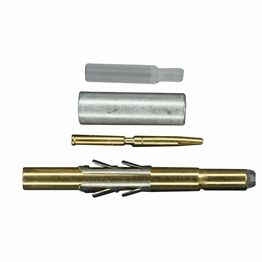Contact connectors
Definition:
Contact connectors, also known as electrical connectors, are devices used to join electrical circuits, allowing the transfer of electrical signals or power between separate components. They are essential in various electrical and electronic systems for establishing temporary or permanent connections.
Function:
1. Signal Transmission: They facilitate the transfer of electrical signals between devices, ensuring communication and data exchange.
2. Power Distribution: They distribute power from a power source to various components within a system.
3. Safety and Reliability: They provide a safe and reliable means of connecting and disconnecting components without causing damage or short circuits.
4. Ease of Maintenance: They allow for easy replacement or repair of components without the need for extensive rewiring.
Applications:
1. Automotive Systems: Used in engine control units, sensors, and infotainment systems.
2. Telecommunications: For connecting cables in telephone and internet networks.
3. Industrial Automation: In PLCs, sensors, and actuators for machine control.
4. Consumer Electronics: In smartphones, laptops, and home appliances for charging and data transfer.
5. : For connecting critical systems in and spacecraft.
Selection Criteria:
1. Type of Connection: Choose connectors based on the type of connection needed (e.g., soldered, crimped, or screw-clamped).
2. Current Rating: Ensure the connector can handle the required current without overheating.
3. Voltage Rating: Select connectors with a voltage rating that exceeds the system's maximum voltage.
4. Environmental Resistance: Consider connectors with appropriate protection against dust, moisture, and other environmental factors.
5. Mechanical Strength: Choose connectors that can withstand the mechanical stress of repeated connections and disconnections.
6. Size and Shape: Select connectors that fit the available space and align with the design requirements.
7. Compatibility: Ensure the connector is compatible with the mating components and follows industry standards.
8. Cost-Effectiveness: Consider the cost of the connector in relation to its performance and reliability.
In summary, contact connectors are vital components in electrical and electronic systems, providing a means to connect and disconnect circuits safely and efficiently. Their selection should be based on the specific requirements of the application, including the type of connection, current and voltage ratings, environmental resistance, mechanical strength, size, compatibility, and cost.
Please refer to the product rule book for details.
Contact connectors, also known as electrical connectors, are devices used to join electrical circuits, allowing the transfer of electrical signals or power between separate components. They are essential in various electrical and electronic systems for establishing temporary or permanent connections.
Function:
1. Signal Transmission: They facilitate the transfer of electrical signals between devices, ensuring communication and data exchange.
2. Power Distribution: They distribute power from a power source to various components within a system.
3. Safety and Reliability: They provide a safe and reliable means of connecting and disconnecting components without causing damage or short circuits.
4. Ease of Maintenance: They allow for easy replacement or repair of components without the need for extensive rewiring.
Applications:
1. Automotive Systems: Used in engine control units, sensors, and infotainment systems.
2. Telecommunications: For connecting cables in telephone and internet networks.
3. Industrial Automation: In PLCs, sensors, and actuators for machine control.
4. Consumer Electronics: In smartphones, laptops, and home appliances for charging and data transfer.
5. : For connecting critical systems in and spacecraft.
Selection Criteria:
1. Type of Connection: Choose connectors based on the type of connection needed (e.g., soldered, crimped, or screw-clamped).
2. Current Rating: Ensure the connector can handle the required current without overheating.
3. Voltage Rating: Select connectors with a voltage rating that exceeds the system's maximum voltage.
4. Environmental Resistance: Consider connectors with appropriate protection against dust, moisture, and other environmental factors.
5. Mechanical Strength: Choose connectors that can withstand the mechanical stress of repeated connections and disconnections.
6. Size and Shape: Select connectors that fit the available space and align with the design requirements.
7. Compatibility: Ensure the connector is compatible with the mating components and follows industry standards.
8. Cost-Effectiveness: Consider the cost of the connector in relation to its performance and reliability.
In summary, contact connectors are vital components in electrical and electronic systems, providing a means to connect and disconnect circuits safely and efficiently. Their selection should be based on the specific requirements of the application, including the type of connection, current and voltage ratings, environmental resistance, mechanical strength, size, compatibility, and cost.
Please refer to the product rule book for details.
Categories
Datasheets
Article

What Is a Potential Transformer (PT)?
Table of Contents + 1. Basic Definition & Background 1.1. What Is a Potential Transformer? 1.2. PT vs Ordinary Transformer vs Instrument Transformer 1.3. Applications of Potential Transformers / What Are Potential Transformers Used For?2. Operation Principle 2.1. Working Principle of a PT / VT 2.2. Voltage Ratio & Turn Ratio Relationship 2.3....
Learn More >
ICkey Named Intel IoT Solution Aggregator, Marking Strategic Milestone in Partnership
ICkey, a leading distributor of electronic components and provider of digital supply chain solutions, has entered into a strategic partnership with global semiconductor giant Intel, becoming an official Intel IoT Solution Aggregator. To commemorate this milestone, the two companies held a signing ceremony under the theme “Smart Connectivity, Powering the Future.” During the ceremony, Bi Fenglei, Senior ...
Learn More >

ICkey Successfully Lists on Shenzhen Stock Exchange ChiNext Board, Empowering Innovation in the Electronics Industry
On September 30, 2025, ICkey (Shanghai) Internet & Technology Co., Ltd. (ICkey) announced its successful listing on the ChiNext Board of the Shenzhen Stock Exchange under the stock code 301563. As a leading vertical B2B supply chain platform in the electronic components sector, ICkey supports the R&D, production, and procurement needs of the electronics manufacturing industry - specifically targeting small and medium-b...
Learn More >





















